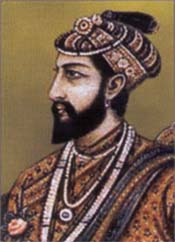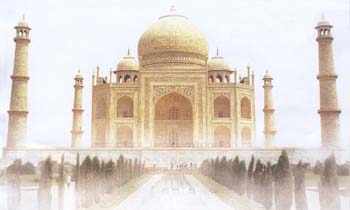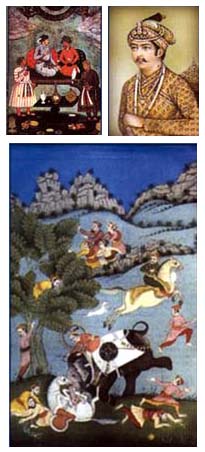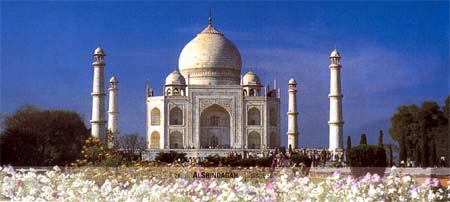|
The Mughal age is famous for its
many-faceted cultural developments. The Timurids had a
great cultural tradition behind them. Their ancestral
kingdom at Samarkand was the meeting ground of the
cultures of Central and West Asia. The Mughals brought
with them Muslim cultural traditions from Turko-Iranian
areas, which inspired the growth of the Indo-Muslim
culture.
The lady was of a high birth - she
was the grand daughter of Mirza Ghiyas Beg (the father of Empress Nur
Jahan), the Prime Minister of the fourth Mughal Emperor
Jahangir, and the daughter of Khawja Abul-Hassan, known
in the court of Jahangir as Yamin-ud-Doulah Asaf Khan- a
man of dignified appearance, respected for his sound
judgment. And he was ambitious too, so it came as no
surprise that he was appointed by Jahangir as a Prime
Minister after the death of Mirza Ghiyas. Thus, Arjumand
Bano Begum who later came to be known as Mumtaz Mahal
was the daughter of a noble parentage. Mumtaz was born
in the year 1594. When she reached the age of learning,
her family took great efforts to give her a proper
education and teach her the graces of the court. With
her natural beauty, they hoped that she would one day be
famous like her aunt Nur Jahan and acquire a high
position in the court of the Emperor of India.
When Mumtaz completed her education and she reached the
age of marriage, the fame of her beauty spread beyond
the confines of the harem, and her accomplishments
became the talk of circles in high society. When he was
sixteen, Prince Khurram (the future Emperor Shah Jahan)
was strolling in the Royal Meena Bazaar when he saw the
beautiful fifteen-year-old daughter of the Prime
Minister. Taken by her beauty, he applied to his father,
the Emperor, the very next day and asked for and was
granted permission to marry her. It was love at first
sight. However, a marriage between Khurram and Arjumand
was not as easy as one might think, for in seventeenth
century Indian courts, marriages of love were almost
unheard of. Royal marriages were made for political
considerations, to cement military coition, to
strengthen family ties, or for other alliances. So, a
year later, Prince Khurram was married to a Persian
princess.
Because Moslem law allowed every man to have four wives,
marriage to Arjumand was not lost even though Prince
Khurram had already committed to his first wife. So,
five years later when the Emperor's astrologers
calculated that the time was correct for a marriage
between them, the long awaited wedding took place at the
house of Mirza Ghiyas. It was a huge affair even by
royal standards. As the procession made its way to
Arjumnad's house, musicians, dancers, and acrobats
entertained the crowds. Officials of state wore robes
embroidered with spun gold on silk. Slaves shooed flies
away, coolies carried torches, and long robed dervishes
said their prayer beads. The Emperor of India attended
the wedding in person and had the pleasure of tying a
pearl necklace to the bridegroom's turban with his own
royal hands. In order to show his great esteem for
Arjumand, Jahangir bestowed the highest of honours on
his new daughter-in-law, a new name. She was now Mumtaz
Mahal or "Chosen One of the Palace". After the wedding,
the prince and Mumtaz were spending together most of
their time. She soon became a political adviser to her
husband and was instrumental in supporting widows,
orphans, and poor families.
Shah Jahan's passionate attachment to Mumtaz Mahal made
the couple inseparable companions, both at home and
abroad and her wise counsel had been of immense help to
Shah Jahan, who consulted her in all political issues.
Both of them had carried the affairs of administration
pleasantly until the year 1619. Until then they had
enjoyed the support of Empress Nur Jahan, which
influence in the court ensured that the couple led a
happy married life. In the meantime, the daughter of Nur
Jahan from her first husband, Sher Afghan Khan, got
married to Prince Shahryar, the younger brother of Shah
Jahan, who was Emperor Jahangir's youngest son by one of
his other wives. The Empress who had always been a
powerful factor in the State, forsaking Shah Jahan, now
espoused the case of her son-in-law, to help him succeed
the throne after Jahangir. Accordingly, she had started
using her wily skills to distance Jahangir from Shah
Jahan.
Her efforts triumphed. She managed to convince the
willing monarch, ever ready to do her bidding, to
chastise his dear son. Shah Jahan tried his best to
regain the trust and love of his angry father, but his
efforts were in vain. The split between the father and
the son grew wider by the day to the point of no return.
Jahangir dispatched a strong force under Prince Parvez
and Mahabat Khan to bring him to heel. At that time,
Shah Jahan who was camping at Burhanpur looked for
safety in flight. He became a refugee in the court of a
Deccan King and then in Bengal. Jahangir's displeasure
lasted for eight years. During this time, Shah Jahan's
days were spent in distress, anxiety, and unrest. It is
said that adversity tries friends. All his companions
who had sworn to defend his life with their own forsook
him and fled. This state of existence continued until
1627 when Jahangir, who had long been suffering from
Asthma, passed away. Shah Jehan came to the throne after
a bloody war of succession. When Jehangir died, only two
of his sons, Shahryar and Shah Jehan were alive.
Shahryar, who was also Nur Jehan's son-in-law, was
seriously sick at the time. Despite this, Nur Jehan
sought vainly to have him ascend to the throne. However,
Shah Jehan, with the aid of his father-in-law, was able
to seize power.
Shah Jehan's coronation was celebrated throughout the
Empire. Men of letters, holy men, nobles, and
high-ranking officials attended the ceremony. As per
custom, Shah Jahan distributed robes of honor to those
attending the ceremony. After attending to the duties of
the State, Shah Jahan hurried to the harem, where his
wife Mumtaz Mahal, now an Empress, had hosted a
brilliant reception in his honor. Trays full of gems and
gold were distributed to the poor on this occasion. The
joy of the happy couple knew no bounds on this occasion,
which had ended their long-sufferings. Shah Jahan
presented his queen two lakhs in gold and six lakhs in
silver, along with a Jagir that yielded ten lakhs every
year. For good measure, he added an annual grant of
fifty lakhs worth of jewelry to be given on the first
coronation anniversary. Two years later, he would
increase it again by another two lakhs.
Shah Jehan was an ambitious ruler like his grandfather,
Akbar. He chose honest people to be his governors and
commanders in the army. He warned them to be fair in
their dealing with the people. He is known in history as
Shahinshah-i-Adil, or the "Just Emperor". He worked long
hours and kept an eye on every detail of administration
of the Empire. He made the roads safe for travelers,
severely punishing looters and robbers. He developed
agriculture and improved trade with foreign countries.
Shah Jehan made it a tradition to distribute to the poor
several times his weight in gold, silver and other
valuables twice a year. The result was that people
became rich and the state revenue increased manifold.

With the accession of Shah Jehan to the throne, came a
flowering of architecture both in Agra and Delhi. The
profusion of white marble buildings raised during the
period of Shah Jehan, led one scholar to characterise it
as the reign of marble. He was a great patrons of the
arts, and Mughal painting and architecture, blending
Persian and Indian traditions, reached their zenith at
this time.
During her husband's reign, Mumtaz Mahal took an active
part in administering the kingdom. In turn, Shah Jahan
would consult her on all the important matters relating
to his government. He entrusted her with his royal seal.
During those times, the royal seal was an object of
greatest care among Muslim rulers. History records the
fact that the seal was entrusted always to a person of
unquestionable honesty and absolute loyalty. For, a
document stamped with it commanded immediate obedience.
This duty was later delegated to her father
Yamin-ud-Doulah on her request.
Mumtaz Mahal was tenderhearted by nature. The weak and
the helpless found in her a sympathetic listener to
their problems. Widows, orphans, and the poor benefited
from her bounty. Her purse became the means for the
indigent to get their daughters married in a decent
manner. Her mercy rescued many criminals from being
executed and reinstating others to their lost rank and
dignity due to royal displeasure.
Shah Jehan adored his wife and built a magnificent suite
of rooms for her in the palace and brought her lavish
gifts. He even took her along with him on his military
campaigns. It was on one of these campaigns that Mumtaz,
pregnant with their fourteenth child, accompanied Shan
Jahan in the fall of 1630. In the spring of 1631, Mumtaz
Mahal died giving birth to their 14th child, a baby
girl. Her heartbroken husband spent approximately two
decades, and much of the money in the royal treasury,
fulfilling his wife's dying wish by building a monument
to their love.
Following Mumtaz Mahal's death, Shah Jahan locked
himself in his rooms for eight days. When he emerged he
was no longer the same man who had gained the throne
four years earlier. He mourned her for almost two years.
When her body was brought from Burhanpur, where she
died, to Agra, the seat of rule for the Mughal Empire,
she was laid to rest in a temporary crypt in a garden
along the banks of the Jumna River. The foundation of
her mausoleum was laid in 1631, and the work was
completed in 1653.
For the construction of this marvellous piece of
architecture, Shah Jahan invited to his court the best
talent from different parts of the world. Architects and
artisans were summoned to the palace in Agra from fabled
lands as far as Baghdad and the Ottoman courts of
Turkey: garden designers from Kashmir, calligraphers
from Sheraz, stonecutters, sculptors, inlay artisans,
dome designers and masons from Bukhara, Constantinople
and Samarkand. There were daily consultations; there
were considerations and compromises. Above all, there
was devotion to the memory of Mumtaz Mahal.
It is believed that Master Isa Afandi from Turkey was
charged with designing the building. Muhammad Khan from
Shiraz and Abdul Ghaffar from Multan were appointed as
calligraphers. Qadir Zaman Khan from Arabia was made in
charge of art and interiors of the building. In short,
the services of the most skilled people of the age were
secured for constructing this grand monument. Each of
them would be paid a handsome monthly salary until the
completion of their work. The laborers and workers
working under them, numbered 20,000 men. It took them
twenty years to complete the entire Taj Mahal.
To satisfy Shah Jahan's artistic obsession, vast
quantities of white marble were mined from the quarries
in Rajasthan; red sandstone was carted from Delhi.
Precious stones were brought by caravan from all corners
of the empire and beyond: jasper from the Punjab,
carnelian from Baghdad, turquoise from Tibet; malachite,
jade and crystal from Turkestan; pearls, diamonds,
emeralds, sapphires ....over forty types of gems in all.
A ten-mile long ramp was built through Agra so materials
could be dragged to the top of the dome at the
construction site. So great was the scope of the project
that the city of Mumtazabad grew up around the grounds
to house the twenty thousand workers who would labor
over twenty years to build this monument.
An immense brick scaffold was erected to support the
assembly of the dome, which entailed much labor and
heavy expenditure. It was said that this structure alone
cost more than the entire work. According to the legend,
when the Taj neared completion, Shah Jahan was informed
that it would take five more years just to dismantle it.
He responded by decreeing that anyone who helped remove
the bricks could keep them, and the job was completed
overnight.
The Taj Mahal's design combined Hindu, Persian, Turkish,
and Buddhist elements in such a way that they were
synthesized into something completely new. Today, the
Taj Mahal has become one of the great visual clichés of
our time. Although we marvel at its beauty and the story
behind its construction, its facade is so familiar to us
that we have forgotten that the Taj Mahal is a
completely original work, totally unique for its time.
In September 1657, Shah Jehan fell ill. The physicians
were not hopeful about his recovery. He even made his
last will and testament. As soon as the news of his
illness reached his four sons, Dara Shikoh, Shuja,
Aurangzeb and Murad, they all started making
preparations to capture the throne. Aurangzeb who
succeeded in his efforts, kept his aged father
imprisoned until his death, allowing one of his sisters
to look after him. Shah Jehan died in 1666. He was laid
to rest beside his beloved wife, Mumtaz Mahal.
Today, the Taj Mahal is considered one of the wonders of
the world. It stands amid acres of gardens on the banks
of the Yamuna River in Agra. The most famous part of the
monument is the tomb of Mumtaz Mahal with its white
marble dome, but the 42-acre complex also includes
mosques, minarets and other buildings.
It has been suggested that Shah Jahan never intended to
be entombed with his wife, but planned to build a
second, black marble Taj to serve as his mausoleum.
However, many scholars doubt this story and believe the
emperor did indeed wish to be buried near Mumtaz Mahal.

|
